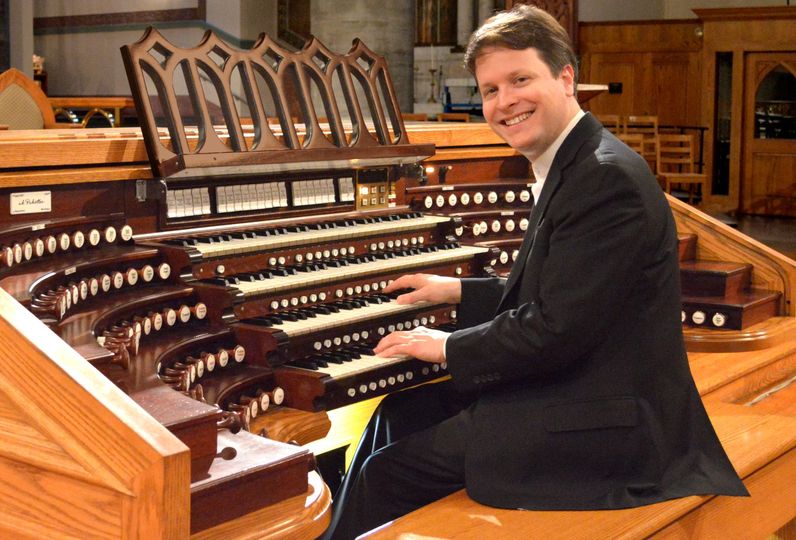Paul Jacobs: César Franck Bicentennial Organ Series in Review
Paul Jacobs, organist
The Church of Saint Mary the Virgin, New York, NY
June 7, 2022
Any opportunity to hear the internationally renowned organist Paul Jacobs in concert is a golden one, so I was delighted to be assigned to this, the second half of his traversal of César Franck’s complete organ works.
Once upon a time, Franck’s D minor Symphony was a staple of orchestra programs everywhere, but lately it seems to have fallen out of fashion. I would wager that aside from the ubiquitous A major Violin Sonata, the music-going public has not heard a note of Franck’s music. However, to church musicians (organists and choir directors) his works are touchstones. For concert organists, they are a rite of passage on the road to mastery of the instrument, as well as a distinct style of playing: Grand French Romanticism.
The issue with touchstones is to reveal what made them new and radical at the time of their creation, rather than add to their smooth, worn quality. In Mr. Jacobs’ hands and feet, we need not worry—he is known for his uncanny ability to clarify the thousands of sonorities (and thousands of notes!) in the most knotty textures, as his complete Bach and Messiaen series have shown (now there’s a contrast!).
The six pieces heard on this occasion are less well known than the products of Franck’s old age (Trois Chorales), with the possible exception of the Prélude, Fugue et Variation. The program notes, which were written for the series as a whole rather than piece by piece, indicate 1868 for the six pieces, the date of publication. These works germinated over a ten-year period, principally from 1859 to 1862, undergoing numerous revisions. Hardly prodigious, you might say, but remember Franck the child had been groomed for a career as a piano virtuoso by his domineering father, and success came slowly with many setbacks until he settled into his true calling as the organist at Paris’ famed Sainte-Clotilde and as a composer.
What a change in the aesthetic was wrought by the advent of Franck! Organists of the Paris society churches in the mid-nineteenth century were content to pander to their congregations with junky “tempest” pieces, and cheap medleys cobbled together from the fashionable operas of Rossini, et al. By comparison, Franck, even at his most extroverted, seems practically austere.
Mr. Jacobs, who spoke from the front of the sanctuary but played the concert “invisibly,” from the gallery, announced that he would change the order of the six pieces. There is documentary evidence that Franck himself did perform them together as a suite at least once. I will gratuitously read Mr. Jacobs’ mind here, and assume that the sixth piece (Final), which is musically the weakest (weak at a very high level) with its bombastic fanfare theme, despite a lovely middle section, he wished to bury in the middle of the concert. He played the pieces in the order 4,5,6,1,3,2. There was no applause invited until the end, adding to the strangeness, for the modern music lover, of an organ recital, though the large church was very full of devotees.
These six works are wildly well-constructed, with interpenetrating themes, foreshadowing Franck’s obsession with cyclic composition. Many of the motives are fully realized later in his life in the D minor Symphony, Also beautifully legible in Mr. Jacobs’ crystalline performance was the obsession with canons and other polyphonic development.
For me, the best performances were the opening two pieces Pastorale and Prière, where the meditative quality was strongest, combined with the beautiful registrations this historic organ provides. The instrument, originally installed by Aeolian-Skinner in 1933 and revised many times, the latest being in 1988, offers many of the features of the grand French organs that Franck would have been used to. The reverb in the church, however, is fairly brief, so some of the halo of sound doesn’t happen at the end of phrases, thus influencing phrasing, timing, rubato, and registration (My, my! Don’t organists have a lot of things to think about?).
The Fantaisie and the Prélude, Fugue et Variation were a bit on the fast side, though Mr. Jacobs’ fastidious logic prevailed and was always convincing. He was supple, but contained, very “French” indeed. The Prélude, Fugue et Variation was robbed of an extra measure of sadness that I feel is essential to the work, however, I may be projecting!
The Grande Pièce Symphonique closed the concert, with its massive deployment of two things: all of Franck’s compositional ingenuity, and all of the organ’s potential. The introduction of the term symphonique led to an entire wave of French symphonies for organ (Vierne, Widor, Duruflé). The slight agogic pause before the last chord was breathtaking.
For a French organ music lover, I would kindly suggest that Mr. Jacobs take a diction lesson when pronouncing the words Grande and Symphonique in French. Side note: It reminds me of one of my former professors, who shall remain nameless, who took umbrage whenever a student would correct her pronunciation of this composer: “I got my doctorate from Indiana University, and I’ll say Caesar Frank if I damn well please!”
You’re in good company Paul. And Franck is in good hands with Paul Jacobs. We organ aficionados look forward to your next series.

